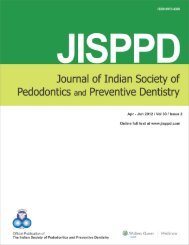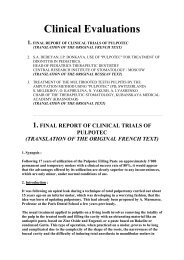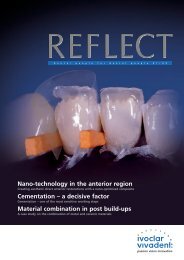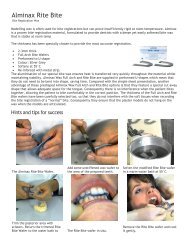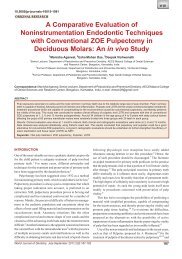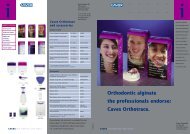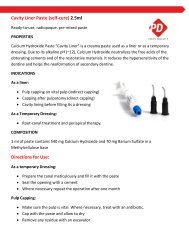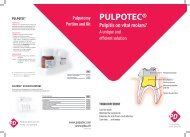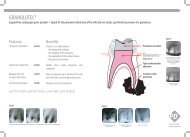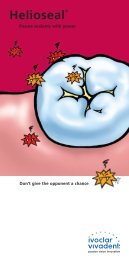temperatureresponsive
View File - universaldental.com.pk
View File - universaldental.com.pk
- No tags were found...
Create successful ePaper yourself
Turn your PDF publications into a flip-book with our unique Google optimized e-Paper software.
Efficient tissue management<br />
with Racegel<br />
The use of a special aluminium chloride gel with reversible <strong>temperatureresponsive</strong><br />
viscosity permits optimised control of bleeding and retraction<br />
in the region of the sulcus<br />
reproduced with kind permission of Deutscher Ärzte-Verlag<br />
Dr Markus T. Firla<br />
Since it was not possible to insert cords for the retraction of the<br />
marginal gingiva, but at the same time, it was imperative to achieve<br />
efficient, but gentle, haemostasis before taking the impression, the<br />
measure chosen for the necessary tissue management was the<br />
aluminium chloride gel Racegel with ambient temperature-responsive<br />
reversible viscosity. This sophisticated material-science property<br />
enables the material to be comfortably applied selectively even to<br />
the narrowest region of the sulcus before it gels into a stable form as<br />
desired due to the warm temperature of the mouth. Note the uniform<br />
gel strand on the right (here, clearly orange in contrast to the pale<br />
pink gingiva) in the sulcus region of the prepared teeth.<br />
Materials for the efficient, that is - from a<br />
practitioner’s viewpoint - quick and gentle<br />
achievement of dry and clearly visible<br />
marginal gingival conditions are of great<br />
benefit in daily tooth care routine involving<br />
direct or indirect treatment. However, the<br />
measures used for a procedure of this kind,<br />
known as tissue management, not<br />
infrequently take as much time as the<br />
subsequent tooth filling or the preceding<br />
preparation of the natural crown of the tooth.<br />
Therefore, this article describes an innovative<br />
product which is extraordinarily suitable for<br />
satisfying the clinical requirements for the<br />
efficient performance of tissue management.<br />
The “three components” of tissue management<br />
The accurate depiction of dental structures for<br />
restorative or prosthetic measures is an<br />
absolute requirement when paramarginal,<br />
submarginal or inframarginal tooth surfaces<br />
have to be worked on or reliably identified for<br />
further treatment stages. This procedure, which<br />
is as a whole termed tissue management,<br />
consists - strictly speaking - of three different<br />
partial steps, which, depending upon the<br />
requirements of each specific case, are<br />
performed individually or in combination:<br />
Haemostasis<br />
Contraction of the marginal gingiva in<br />
question (by means of astringent agents),<br />
Retraction of the gingival cuff (by means of<br />
mechanical force)<br />
4
Four different products for gingival “tissue management”<br />
(haemostasis - contraction - retraction). Reversible <strong>temperatureresponsive</strong><br />
viscous Racegel from Septodont (second substance<br />
from the left) demonstrates its ability to undergo transient gelling on<br />
the glass plate heated to about 30 °C. In these temperature<br />
conditions, which are comparable to those in the oral cavity, this<br />
product is neither too solid nor too liquid. It is also evident that,<br />
compared to other materials, there are no problems discharging it<br />
from the thin application syringe at room temperature and that<br />
continuously uniform application is possible. Material-specific<br />
factors are very beneficial to manipulation both when using<br />
retraction cords and without them.<br />
If we ignore the fact that the most reliable<br />
method of avoiding bleeding of the sulcus tissue<br />
caused by treatment-induced irritation is to<br />
protect these structures by means of atraumatic<br />
procedures per se or to protect them by means<br />
of suitably positioned aids (wedges, cords,<br />
protective instruments, etc.), the termination of<br />
the bleeding of affected marginal gingival<br />
regions may be accelerated by means of agents<br />
which act appropriately on these regions, such<br />
as, for example epinephrine, aluminium sulfate,<br />
iron sulfate and aluminium chloride or locally<br />
applied compression by means of cotton rolls<br />
or caps, cords placed in the intracrevicular<br />
space or the like.<br />
From the clinical aspect, this means that<br />
traditional tissue management methods<br />
frequently use a combination of measures for<br />
haemostasis and retraction of the marginal<br />
gingiva in the sulcus region. The classical<br />
example is the insertion of a cord, which has<br />
previously been soaked in a haemostatic agent,<br />
in the gingival pocket. However, this<br />
combination of two, in principle very different,<br />
processes can result in tissue loss in the<br />
marginal periodontium. In particular, in the case<br />
of very thin and narrow gingival conditions,<br />
otherwise favourable impacts of individual<br />
measures may be detrimental in combination.<br />
Therefore, whenever planning manipulations in<br />
the marginal periodontium, it is advisable to<br />
consider which procedure will be the least<br />
compromising for the tissue affected. For<br />
example, the use of suitable cords in the dental<br />
sulcus region is an excellent possibility for<br />
achieving a targeted and efficient, but also<br />
gentle retraction of the gingiva and even<br />
- depending on the prevailing initial situation -<br />
for achieving an additional haemostatic action<br />
due to the compression of the microvessels.<br />
However, here it is necessary to take into<br />
account the length of time that compression<br />
acts on individual gingival regions in order to<br />
exclude the possibility of subsequent necrosisinducing<br />
ischaemia. Although mechanical<br />
retraction in combination with astringent agents<br />
is very useful for a bloodless treatment area,<br />
consideration should be paid in advance to the<br />
total amount of time that will be required.<br />
For the prudent implementation of tissue<br />
management, it is important to know that<br />
epinephrine is absorbed via exposed regions of<br />
tissue into the organism where it can have<br />
detrimental systemic effects, known as the<br />
epinephrine syndrome. This can result in<br />
tachycardia, raised blood pressure, rapid<br />
respiration, headache and anxiety or even<br />
psychological stress. In addition, the<br />
vasoconstrictive action of epinephrine only lasts<br />
for a limited period and, as a result, the vessels<br />
in the affected tissue can undergo relaxation<br />
during the decisive impression process.<br />
Although aluminium sulfate, which has been<br />
known as a method for general haemostasis for<br />
a long time, does not trigger any adverse<br />
systemic effects, but in gingival tissue it can<br />
result in an identifiable atrophy of the underlying<br />
alveolar crest. Another problem is the<br />
unpleasant taste, which not infrequently causes<br />
discomfort to the patients treated with this<br />
substance. The sulfur content can also inhibit<br />
complete setting of addition-curing silicone<br />
impression materials if aluminium sulfate is not<br />
completely removed from the regions from<br />
which an impression is to be taken.<br />
5
The prepared premolars from Figures 2 and 3 following two minutes’<br />
exposure to the gel containing 25% aluminium chloride and<br />
subsequent spraying of the gel with water from the multifunction<br />
syringe on the treatment table. Since this special product is rapidly<br />
and completely liquefied at low ambient temperatures for tissue<br />
management, it can be completely removed rapidly and without<br />
problems by means of a water spray. The marginal gingiva have<br />
perfect haemostatic conditions and we can also identify a marked<br />
contraction of the gingival sulcus tissue. It is also possible clearly to<br />
evaluate the status of the stumps and the respective type of<br />
preparation.<br />
Clinical view directly after the preparation of two mandibular<br />
premolars. The grinding of the teeth for the later acceptance of<br />
primary telescoping crowns had to be performed without<br />
intracrevicular cords protecting the surrounding gingiva since the<br />
marginal gingival pockets were only about 0.5 mm deep. However,<br />
the instruction to leave the longest possible stumps for stable<br />
anchorage of the telescopic crowns did not allow any other option<br />
than to allow the preparation limits to extend as far as<br />
physiologically acceptable into the sulcus region of the teeth. This<br />
resulted in bleeding of the marginal gingiva in the regions affected<br />
by the diamond grinding tool.<br />
The latter also applies to iron sulfate, which is<br />
one of the most recognised agents for the rapid<br />
local arrest of bleeding, since its haemostatic<br />
effect is in particular based on intravasal<br />
coagulation in the ends of the exposed vessels.<br />
However, at the same time, sudden coagulation<br />
- including of the blood in the gingival cuff - and<br />
the, in some circumstances, resultant extreme<br />
accumulation of blackish-brown particles of<br />
coagulum in the treated areas can also be seen<br />
as a serious drawback specific to this<br />
substance since the necessary removal of the<br />
superficial blood clots can be time-consuming<br />
and laborious.<br />
Like aluminium sulfate, a buffered aluminium<br />
chloride solution does not have any systemic<br />
effects when applied topically for haemostasis.<br />
The tissue damage potential for the gingiva of a<br />
25% aluminium chloride solution is comparable<br />
to that of a 15% iron sulfate solution, with both<br />
these agents being markedly less harmful to the<br />
gingiva than aluminium sulfate.<br />
Racegel<br />
As a buffered glycol-based 25% aluminium<br />
chloride gel which exhibits reversible<br />
temperature-responsive gelling behaviour,<br />
which is very useful to practitioners, Racegel is<br />
easy to apply without streaking or agglutination.<br />
On application to the tooth substance and the<br />
marginal gingival tissue, the thermal activation<br />
that occurs during adaptation to the<br />
temperature conditions in the oral cavity brings<br />
about a change in the viscosity of this material<br />
allowing its targetted application - since it is<br />
initially free-flowing - in a thin strand even to<br />
hard-to-access cervical cavities and preparation<br />
areas. Then, due to the thermally induced<br />
gelling, it remains securely in a dimensionally<br />
stable form at the site of the wetting of the<br />
periodontium. The excellent adhesive force until<br />
sprayed with cooler spray water from the<br />
multifunction syringe, even on steep slopes of<br />
ground teeth, is a product-specific achievement<br />
of material science attributable to the<br />
temperature-responsive reversible gelling<br />
capacity of this material.<br />
From a clinical aspect, another benefit is that the<br />
use of this product does not cause any<br />
discoloration of the gingiva. Neither do any<br />
6
lood clots form and so there is no need for<br />
laborious cleaning of the visible treatment area.<br />
The exposure time required for optimum<br />
haemostasis is 2 minutes per application.<br />
However, it has been found, that with low<br />
bleeding levels, this period can be even shorter<br />
due to the very good haemostatic action of this<br />
aluminium chloride gel. However, in the case of<br />
larger areas of gingival bleeding, it should be<br />
noted that, in the case of multiple applications<br />
of the material, an overall exposure time of ten<br />
minutes for the same area of tissue must not be<br />
exceeded in order to avoid the risk of<br />
destructive effects on the marginal periodontal<br />
tissue.<br />
The pronounced haemostatic effect is<br />
accompanied by a clear astringent effect. In<br />
suitable cases, this enables mechanical<br />
retraction of the free gingiva (for example with<br />
cords inserted in the sulcus) to be dispensed with<br />
entirely. Particularly with very delicate marginal<br />
gingival conditions in aesthetically critical regions<br />
of the jaw, it is impossible to overvalue the<br />
advantage of this possibility of dispensing with<br />
the, in some circumstances - despite the greatest<br />
care - excessively traumatic displacement of the<br />
marginal gingiva with respect to the retention of<br />
the gingival cuff in the treatment area. Particularly<br />
with all-ceramic crowns and veneer work in the<br />
region of the upper anterior teeth, the risk that the<br />
post operationem “by a whisker” aesthetically<br />
displeasing atrophied bucco-cervical marginal<br />
gingiva of a tooth represents a permanent threat<br />
on the incorporation of the finished restoration,<br />
even for an experienced, dexterous and cautious<br />
practitioner.<br />
Ah. And, the use of Racegel avoids yet another<br />
problem: the taste which the patients find so<br />
unpleasant. On contact with the tongue and its<br />
further distribution in the oral cavity, this<br />
innovative gel only produces a slightly acid<br />
impression with a hint of bitter fruit and with no<br />
strong unpleasant aftertaste… The best thing<br />
would be to try it for yourself!<br />
In order to “err on the side of caution”, when taking the impression for the production of<br />
the laboratory-made long-term temporaries, before the primary impression during the<br />
correctable impression technique after the action and subsequent spraying of the<br />
described 25% aluminium chloride gel, knitted cords (Ultrapak Retraction Cords,<br />
Ultradent Products) were inserted into the gingival pockets. A perfect, advantageous<br />
combination of a chemically-induced haemostatic-contracting action and mechanical<br />
retraction. All in all, a gentle yet efficient - and above all rapid - method of tissue<br />
management.<br />
The remaining upper anterior teeth of a 67-year-old female patient following the removal<br />
of the splinted single crowns in regions 11 to 13 and 21 to 23. The crowns had to be<br />
removed after the presence of combination restorative dentistry for more than 20 years<br />
due to the irreversible loss of the removable partial prosthesis during the necessary<br />
renewal of the maxillary prosthesis. In the regions of splinted crowns and the locations<br />
of the distal attachments on the canine teeth, the marginal gingiva had pronounced<br />
inflammation. To enable systematic periodontal treatment to be performed before the<br />
final prosthetic care, it is necessary to protect the anterior teeth with “periodontalfriendly”<br />
and “oral-hygiene promoting” long-term temporaries. To this end, initial gentle<br />
repreparation of the teeth is necessary.<br />
The remaining mild intracrevicular seeping haemorrhage was arrested by another<br />
selective application of the gel directly into the marginal sulcus regions. (Note the stable<br />
gel layer in the cervical region of the stump of 21 after application from the thin needle).<br />
Here, once again, we can see benefits of the thermogelling properties of the material<br />
which permit precise application into the desired areas and immediately thereafter<br />
effect stable adherence to the wetted solid and soft tissue. The exposure time until<br />
repeat spraying was once again two minutes.<br />
7
Even the most careful preparation caused massive bleeding, which<br />
with an initial, relatively extensive application of Racegel was<br />
virtually completely arrested (see photo). As specified by the<br />
manufacturer, Septodont, the aluminium chloride gel was allowed to<br />
act for two minutes. After this, the blood and the gel were thoroughly<br />
sprayed off using a suitable water spray.<br />
The subsequent correctable impression directly after the impression.<br />
Although very delicate due to the extremely shallow sulcus regions,<br />
the preparation limits are clearly visible. All quality criteria required to<br />
produce a perfect prosthodontic master model have been met. It is<br />
also evident that the use of high-dose aluminium chloride gel has not<br />
caused any material-induced drawbacks with respect to the curing<br />
of the A-silicone used (Hydrorise Putty fast set and Hydrorise Extra<br />
Light Body fast set, Zhermack GmbH).<br />
Conclusion<br />
The product Racegel for gingival tissue<br />
management during precision impressions and<br />
fillings extending into the paramarginal or<br />
submarginal gingival sulcus, which the<br />
manufacturer Septodont launched on the<br />
dental market represents an innovative “hightech<br />
material” with which the tissue of the<br />
marginal periodontium can be prepared gently<br />
with no mechanical injury or pain to the patient.<br />
The temperature-responsive variable viscosity<br />
of this gel containing 25% aluminium chloride<br />
means that, until it has heated up to mouth<br />
temperature, it can be applied in free-flowing<br />
state by means of extremely fine needles with<br />
optimum control, even in hard-to-access<br />
gingival pockets. When mouth temperature is<br />
achieved and the thermogelling effect sets in, it<br />
remains stably in situ without slipping or<br />
running off.<br />
The, once again, simple, rapid and complete<br />
removal of Racegel is greatly assisted by the<br />
fact that, when sprayed with water from a<br />
multifunction syringe, the temperature of the<br />
material drops markedly again returning it to a<br />
fluid state in which it can be easily rinsed off.<br />
Following the required exposure time of<br />
2 minutes, the atraumatic astringent effect on<br />
the periodontal soft tissue is manifested as<br />
optimally controlled haemostasis and sulcus<br />
opening.<br />
Compared to other - not as effective - products,<br />
Racegel is definitely worth its price, considering<br />
the cost-benefit ratio. After all, there is no doubt<br />
that the principle “time is money” applies at all<br />
stages of efficient gingival tissue management<br />
during dental prosthetic measures, including<br />
preservative fillings.<br />
Author:<br />
Dr Markus T. Firla<br />
Hauptstrasse 55<br />
49205 Hasbergen-Gaste<br />
Email: Dr.Firla@t-online.de<br />
8
References<br />
1. Firla MT: Productivity counts. Dental Product Report Europe 2007; 28: (2) 43-44.<br />
2. Albers H F: Impressions - A Text for Selection of Materials and Techniques. Ed. I, Alto Books.<br />
Santa Rosa 1990.<br />
3. Paffrath C M et al.: Impression - what to consider? ZMK 2008; 24: (10) 654-670.<br />
4. Albers H F: Impression Taking Systems. The Adept Report 1990; 1: (2) 9-16.<br />
5. Wöstmann B et al: Influence of moisture on accuracy of impression in a sulcus-fluid model.<br />
Dtsch Zahnärztl Z 1999; 54: (8) 631-633.<br />
6. Wöstmann B: Impression: tips for standardisation. Dtsch Zahnärztl Z 2009; 64: (3) 142-145.<br />
7. Hahn R (ed): Precision Impressions. Practical Guide 5. DentalSchool GmbH. Tübingen 2006.<br />
8. 3M ESPE: Making Better Impressions - Expert Education - Impressioning Trouble Shooting Guide.<br />
3M ESPE AG. Seefeld 2007.<br />
9. Wirz J., Wöstmann B.: Precision Impressions - A Guideline for Theory and Practice. 2nd edition,<br />
3M ESPE AG. Seefeld 1999.<br />
9



